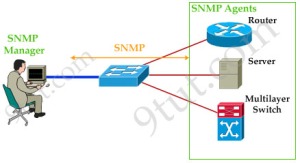The Simple Network Management Protocol or SNMP is a familiar site in most networks. It not only offers ways for event notification but also for getting device statistics, set configuration limitations, and several other operations. In this post, we will take a look at some of the fundamentals of SNMP.
SNMP concepts:
SNMP is a protocol that works at the application level; it defines a procedure of communication between different networking devices and a central administrator for monitoring and management of these devices and networks.
Components of SNMP:
There’re three components related with SNMP:
 • SNMP manager – it is a central system that checks traffic received and sent by the different device SNMP agents. It also manages all devices in the network through these agents. It not only offers ways for event notification but also for getting device statistics, set configuration limitations, and several other operations.
• SNMP manager – it is a central system that checks traffic received and sent by the different device SNMP agents. It also manages all devices in the network through these agents. It not only offers ways for event notification but also for getting device statistics, set configuration limitations, and several other operations.
• SNMP agent – it is a software unit that exists inside a network device; this component is employed to maintain real time information regarding the elements operations. Also, the agent is employed to communicate this information back to the SNMP manager and perform control action set by the SNMP manager.
• MIB (Management Information Base) – the Management Information Base is a practical information storage area where network management information is kept. Inside the MIB there’re several diverse collections of objects that are linked together. Each of these collections holds several variables that can be changed by the SNMP manager or SNMP agent.
SNMP Operations:
Once these components have been configured in a network, they’re capable of performing many operations. The accessible operations rely on what version of SNMP is used over the network.
The following operations are available for all versions of SNMP :
• GET – this operation is performed by the SNMP manager to recover one or more object instances from the SNMP agent.
• GetNext – this operation is for the SNMP manager to get the next object instance from the SNMP agent.
• SET – this operation is for the SNMP manager to set the value of an object instance of the SNMP agent.
Summary:
The use of SNMP has been a long time staple inside the network of several organizations. These days SNMP agent simulators are being used widely by several organizations to deal with a complicated network system effectively.







0 comments:
Post a Comment